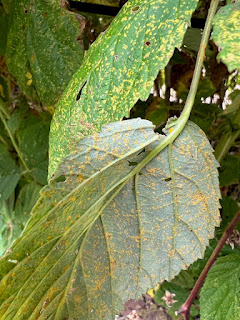Rust is a fungus that manifests itself as yellow, red or rust-brown speckles on leaves and stems of plants. Rust loves wet warm conditions and is hard to get rid of once you have it. This blog post shows examples of Rust and offers organic strategies for containing it.
Rust on broad beans
Rusts - plural, because there are thousands of varieties - are pathogens of order Pucciniales that are highly specialised and infect only very particular plant hosts. Rust on garlic, for instance, will not affect plants in your garden that are not part of the Allium family. Rust spores may arrive by wind, via water, insects, live plant material or garden tools.
Usually Rust is not fatal. Depending on what plant variety is affected, Rust can be just a minor nuisance or have a real impact on the quality and quantity of your crop. Rust on leaves affects photosynthesis resulting in a plant becoming less healthy.
What to do about it
In Tasmanian food gardens Rust is found on, but not limited to, broad beans, raspberries, garlic, tomatoes and beans. Peas are much more susceptible to another fungus named Mildew (see Preventing and Overcoming Mildew on this blog.
 |
| Rust on Leek |
It is generally acknowledged that Rust is hard to get rid of, once it is present. Fungicides are not very effective.
Here is an organic approach to controlling Rust:
Hygiene
Rust may well arrive on the wind. However, it can also arrive via plant material you add to your garden. Always check seedlings and plants, including the underside of leaves, to make sure you do not introduce Rust to your garden. Ideally you quarantine new plants for a fortnight outside your garden before bringing them into your garden. Wash tools after working on affected plants, so you do not spread Rust to other plants.
Create an uninviting environment
Rusts love moist humid conditions. Plant or sow your plants far enough apart so there is always ample ventilation around them. Where appropriate, prune plants to improve ventilation. Overhead irrigation provides good conditions for the development of Rust, so use drip irrigation where possible. Plant or sow in well-draining soil. Collect and remove fallen leaves, especially in crops that have Rust on them.
 |
| Well advanced Rust on broad beans |
Crop rotation is an important tool in making sure that where you had Rust last season you won’t have it again this season. After having Rust, make sure you do not plant members of the same family in the same spot for the next few years. Rotating crops is not hard. Read more about it in The Importance of rotating crops on this FGG blog.
Remove early infections
Remove affected leaves as soon as you see them. This can stop Rust spreading right through a plant or to nearby other plants of the same variety. Do NOT compost these leaves, but remove them from your garden.
Ask yourself whether action is needed
Rust on raspberries and broad beans often has little effect on the quality and quantity of the crop, so there is no real need to do anything, also because Rust on these crops will not affect plants of other plant families in your garden.
 |
| Rust on raspberry leaves |
Whether action is needed or not also depends on when in the life cycle of the plant the Rust arrives. If, for instance, broad beans catch Rust while flowering, action is needed. However, if they get it when most pods are well-developed, don't worry about it.
It is generally acknowledged that Rust is hard to get rid of. Fungicides may limit the impact of Rust, but it is unlikely that they will eliminate it. In addition to the other measures mentioned above, you could use one of the organic fungicides mentioned below.
You could use Bordeaux Mix or Burgundy Mix. Their copper content will have an impact. You can make these sprays yourself. For recipes see Homemade Pest Control Sprays on this blog.
Neem Oil is a commercially available organic spray that will also limit the impact of Rust.
More about Rust on Garlic
 |
| Rust on Garlic |
Garlic is an example of a plant that can be quite affected by Rust. At the end of the season garlic bulbs may be significantly smaller than normal if the plants had Rust for most of the season. For garlic make sure to apply all the strategies mentioned here. Do not plant other members of the Allium family in the same spot for several years.
You can plant well-dried cloves from an affected crop next season without affecting the new plants because Rusts only live on living plants. There is no suggestion anywhere that Rust can be transferred via seed.

No comments:
Post a Comment
Note: Only a member of this blog may post a comment.